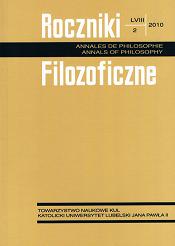Wątki egidiańskie i tomistyczne w koncepcji esse Jana Wersora
The Themes of Giles's of Rome and Thomas Aquinas's in the Concept of esse in John Versor's Philosophy
Author(s): Magdalena PłotkaSubject(s): Philosophy
Published by: Towarzystwo Naukowe KUL & Katolicki Uniwersytet Lubelski Jana Pawła II
Keywords: medieval philosophy; metaphysics; existence; John Wersor; Thomism
Summary/Abstract: The aim of this article is to show that John Versor’s concept of esse presented in his commentary on De ente et essentia by Thomas Aquinas is not in accordance with the Thomistic view. Versor distinguishes two kinds of esse: esse essentiae and esse existentiae. The former pertains to non-substantial beings, and the latter pertains only to the substances. Additionally, esse existentiae is regarded as the proper act of substance. This theory of “double esse” is not to be found in Aquinas’ works; yet, it has been worked out by Giles of Rome, who seems to be the source of inspiration for Versor. Moreover, the further influences of Giles of Rome upon Versor’s philosophy can be found in his consideration of real difference between essence and existence. Therefore, in respect of the concept of esse, due to influences of Giles of Rome, John Versor cannot be regarded as the follower of Thomas Aquinas in the strict sense.
Journal: Roczniki Filozoficzne
- Issue Year: 58/2010
- Issue No: 2
- Page Range: 81-95
- Page Count: 15
- Language: Polish

